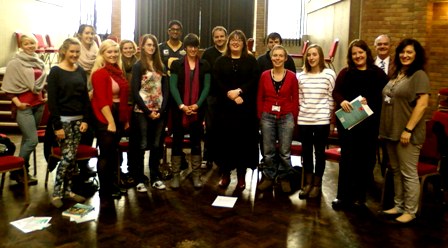From the wealth of auditions over a two-day period, this year’s Chamber Choir has emerged, phoenix-like, from the ashes of the last. This year the Choir is larger than in previous years, so much so that we’ve had to change rehearsal venue from the Old Telephone Exchange to Grimond Lecture Theatre II.

The new team!
Over the first two rehearsals, we’ve begun exploring the repertoire for this year’s series of concert engagements, which has grown to include ‘Advent by Candlelight’ in St. Mildred’s Church in Canterbury in December, and a concert at St. Gregory’s, Wye – these alongside the customary performances in the University Carol Service at the end of term, and the Cathedral Crypt concert in February. A packed year indeed… (More details on our on-line events calendar here).
The theme for this year’s Crypt concert is music from England, Wales and Scotland, and in the first rehearsal we worked through motets by William Byrd and Sir John Tavener; for the Advent concert, we began singing some Advent antiphons from manuscripts dating from the four-stave notation system popular until the sixteenth century; this gives the choir the chance to read from historical notation and an added sense of the past to the music being sung. We also began working at a carol I’ve written for the December Carol Service, a setting of A Babe is Born, which employs open-fifth pedal chords to create a medieval atmosphere.
 Also bursting back to life this term is the Cecilian Choir, formed from Scholars, students, staff and alumni. The Cecilian Choir was a new venture last year, and is back by popular demand: rehearsals begin next week, and we’ll be working towards a very exciting programme for performance in the Spring term, about which more will be revealed later…
Also bursting back to life this term is the Cecilian Choir, formed from Scholars, students, staff and alumni. The Cecilian Choir was a new venture last year, and is back by popular demand: rehearsals begin next week, and we’ll be working towards a very exciting programme for performance in the Spring term, about which more will be revealed later…
It’s an exciting time: new musical students, new ensembles forming, and the beginning of this year’s musical journeys exploring old and new repertoire. As a conductor, first rehearsals are terrifying: will everyone turn up, will they get on with each other, will the balance of the voice-parts work, will they like the repertoire I’ve chosen, how quickly will they learn the music, and, perhaps most importantly – will they enjoy themselves and want to come back next week ?
You can follow the story of the choirs here, from first rehearsal to final performance; we’ll also be bringing you audio clips of the choirs in rehearsal and sneak previews of some of the pieces being performed this year. Stay tuned…
(And if you’ve a fond recollection or stories from your experience with the Chamber Choir in previous years, get in touch: we’ll be featuring them in a regular column here.)



 The Cecilian Choir drew its first breath this week, launching into its programme of repertoire for the year and beginning with Tallis and Lassus.
The Cecilian Choir drew its first breath this week, launching into its programme of repertoire for the year and beginning with Tallis and Lassus.